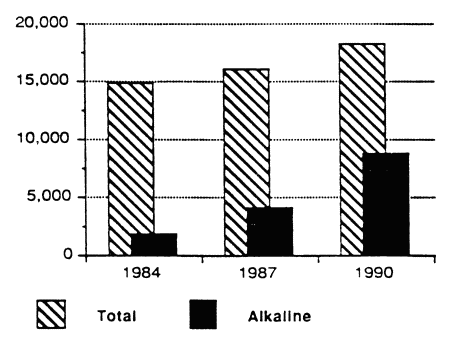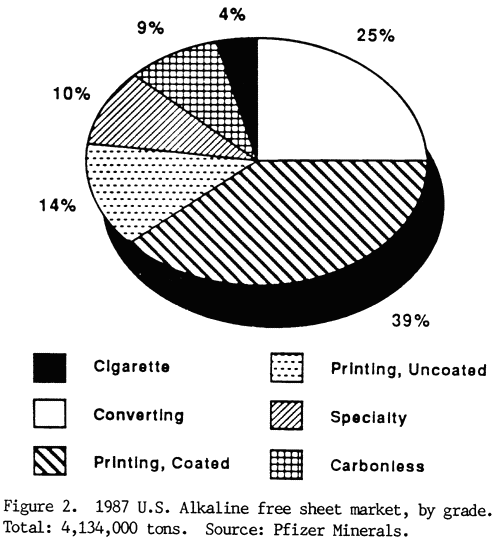

Reprinted with permission in abridged form from The Datek Imaging Supplies Monthly 2(3), March 1988, p. 1-4, where it appeared under the title "Alkaline Papers Gaining Market Share: A Change for all Consumables." Publisher is Datek Information Services (A CAP International company), PO Box 68, Newtonville, MA 02160 (617/893-9130).
In the week of March 14, an alkaline sized cut-sheet product from International Paper became the first such paper qualified by Xerox for use in its copiers. After extensive testing, International Paper gained the approval of a new paper produced by its #8 machine at Ticonderoga. Xerox will sell the paper, which it will designate for use in its 4024 DP and 4200 DP copiers.
This development is an important one for the current prospects of alkaline chemistry, which is now changing the papermaking field worldwide. After decades of producing paper that was acidic in content, the industry is increasingly manufacturing alkaline products. The European paper mills, which began this trend 20 years ago, have now mostly converted to the new alkaline processes. Japanese and American concerns are following this lead. In the United States, where only 5% to 9% of business papers are presently alkaline, use of the new technology here is expected to increase fivefold by the end of this decade, according to an estimate by CAP International, a market research company. Pfizer Minerals predicts a doubling in production of alkaline free sheet (paper free of groundwood, a more inclusive category) during the same period, both as a proportion of total free sheet and in absolute number of tons (Fig. 1). Observations by a number of research staffs and industry analysts vary only in terms of how much and how fast change is taking place, but they consistently indicate an impressive growth in the use of alkaline sizing.

Figure 1. North American free sheet market (thousands of tons). Source: Pfizer Minerals.
Although there are important economic and ecological reasons for the change, it is a controversial one for the makers of copiers, computer peripherals, offset technology, and ultimately for the consumables industries. Uncertainties about product performance and interaction with inks and toner head a list of concerns about the change, which is being followed with interest by all parts of the imaging world.... For example:
In spite of these concerns, there have been a number of important conversions to alkaline processes, and more are planned. Hammermill, which has already converted its mill at Grays Harbor, WA [and the one at Erie PA], since this was written], will be 100%. converted by the end of 1989. International Paper, Hammermill's parent company, so far has converted its operations at Ticonderoga, NY, and will eventually change its fine paper production to alkaline. IP materials engineer Larry Stowell noted that the #8 machine there is the largest alkaline machine in North America, producing paper at speeds of up to 2,100 feet per minute.
According to Dana Mead, the company's senior vice-president for white papers, engineering advances obviate many concerns. The size and shape of calcium carbonate particles, he says, are now carefully controlled by the precipitating method that produces them, as opposed to grinding techniques, which are harder to regulate and are used with natural calcium carbonate. He added that the precipitated calcium carbonate eliminates contaminants such as silica, were associated with natural sources and are a main cause of abrasiveness.
Manufacturers of calcium carbonate, such as Pfizer Minerals (Bethlehem, PA [HQ in NYC]), provide other important insights into the changing story of paper production. Harrison, a Pfizer marketing specialist, commented that in the five years preceding the company's 1987 analysis of the U.S. alkaline free sheet market (Fig. 2), the strongest growth was in specialty papers, printing and writing grades, and converting grades such as forms bond.

Figure 2. 1987 U.S. Alkaline free sheet market,
by grade.
Total: 4,134,000 tons. Source: Pfizer Minerals.
Among other industry observers there are a number who advise caution. One is Larry Anderson of Anderson Associates (Vancouver, WA). In a recent interview he said: "The problem with alkaline sizing is that there could be unanticipated physical or chemical surface reactions, already seen in some business form applications, where image degrading effects have been noted."
Anderson urges subtle testing of new alkaline papers in combination with imaging supplies. One area of concern, he says, is the long term adhesion of toner to laser and copier-paper. Another potential weakness, according to Anderson, is the combination of check writing, and MICR, with alkaline stock, which may create problems in machine readability. Similarly, he urges care in the use of "fugitive" dyes on the new paper.
Peter Oliver, of Andover International Associated (Danvers, MA), offers another Perspective. He noted that International Paper's commitment to alkaline is an important one, comparing its industry leadership to that of U.S. Steel in its field. He noted also that the acceptance of alkaline papers at hardware makers such as Xerox will be critical to alkaline sizing's success in the cut sheet market-
Oliver elaborated on some of the delicate refinements required. Higher dusting increases friction, and affects sheet feeding characteristics. The right level of calendering--pressing the paper between rollers--may improve sheet feeding, but at the same time the wrong level may actually increase dusting.
Oliver stated further that alkaline paper may meet opposition in the business forms market, where a staple stock is 16 and 18 lb. forms bond. This is a light, thick sheet, full of bulky fibers and having a low cost per unit of surface area. Alkaline processing makes it harder to produce the same high bulk sheet. Price changes in forms bond, though, continue to favor any process that will make the product less expensive: International Paper, Champion, and James River plan to raise the price of the forms bond $50 to $60 per ton on April 1, about a 6% increase.
Hardware makers are also following the changes in papermaking. For legal and practical reasons, Xerox, Kodak and IBM all shy away from formally endorsing paper products. Xerox appears to take the most rigorous approach to analyzing and testing new papers. According to George Treier, paper expert and Xerox product design manager, Xerox will qualify particular products of individual machines, and only for use in specific Xerox hardware.
Other manufacturers take different approaches. According to Doug Kirchoff, paper technologist for Kodak, his company is starting to study the use of alkaline papers in its copiers, but so far the change has not been much of an issue for Kodak. He acknowledged, though, that his company's licensing agreements with Hammermill give new impetus to Kodak's research on the topic.
Charles Hill, an IBM staff engineer specializing in supplies, emphasized that his company does not approve or disapprove particular paper products. At the same time, he said, IBM is alert to the problems commonly attributed to alkaline papers. He noted, though, that recent company history may contain at least one tacit acknowledgement of the new technology's recent improvements: the Forms Design Guide for the IBM 3800, which originally prohibited the use of alkaline papers, now contains only a warning.
Although the concerns of hardware manufacturers and others may require special research and design, the papermaking industry appears to be moving steadily towards alkaline sizing. The constraint of higher paper prices, which could ultimately slow growth in machine usage, may well make hardware manufacturers more receptive to alkaline processed products. Solutions to problem noted above will come in large part from the joint efforts of the paper and hardware industries, and they will tend to be proprietary. Makers of consumables, though, must also anticipate and be ready to address changes that alkaline sizing will cause.